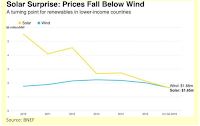 The headline news – long awaited by renewable enthusiasts – is based on a number of recent competitive auctions in sunny deserts of Chile and the Middle East resulting in record-cheap solar prices. (Read the fine print for details of when, where and under what conditions this applies.)
The headline news – long awaited by renewable enthusiasts – is based on a number of recent competitive auctions in sunny deserts of Chile and the Middle East resulting in record-cheap solar prices. (Read the fine print for details of when, where and under what conditions this applies.)According to the latest data from Bloomberg New Energy Finance (BNEF), unsubsidized large-scale solar is beginning to beat not only wind but also coal and natural gas at current prices. If true, and if the same begins to apply elsewhere, it will be a turning point in global electricity markets making solar-generated power the cheapest form of electricity generation.
The BNEF’s accompanying chart, which shows the average cost of new wind and solar from 58 recently completed projects and/or auctions in places such as China, India, and Brazil suggests that the solar’s steep price drop since 2010 has caught up with wind – which has more or less held steady in the recent past.
...
BNEF’s Liebreich acknowledges that, “… the overall shift to clean energy can be more expensive in wealthier nations, where electricity demand is flat or falling and new solar must compete with existing billion-dollar coal and gas plants,” adding, “But in countries that are adding new electricity capacity as quickly as possible, renewable energy will beat any other technology in most of the world without subsidies.
...
Not surprisingly, BNEF concludes that emerging markets have taken the lead over the 35 member nations of the Organization for Economic Cooperation & Development (OECD) in renewable investment. In 2015, the former invested $154.1 billion compared to $153.7 billion by OECD members, a trends that is likely to gather momentum. The lower costs of renewables and the need for new capacity additions makes renewables a good fit for rapidly growing economies. Climate concerns and the Paris Agreement to cut down emissions is mere icing on the cake.
Read more at Turning Point: Solar Cheaper Than Wind

No comments:
Post a Comment